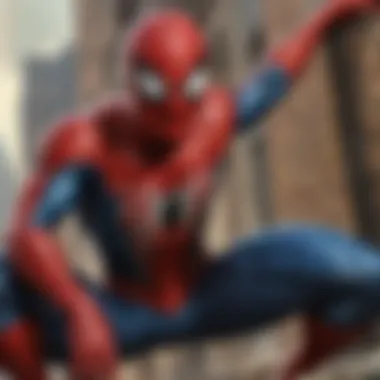Exploring the Iconic Imagery of Spider-Man Across Media


Intro
The fascination with Spider-Man transcends generations. With his unique blend of relatability and superhuman abilities, he resonates with a vast audience. The imagery surrounding Spider-Man evokes strong emotions and sparks creativity, while representing the ideals of heroism, resilience, and everyday struggles.
Spider-Man Character Analysis
Background
Spider-Man* made his first appearance in „Amazing Fantasy” #, published in 1962.
Created by Stan Lee and Steve Ditko, his origin story brings a compelling mix of tragedy and triumph. Peter Parker, a high school student, gains spider-like abilities after being bitten by a radioactive spider. This origin underscores themes of responsibility, famously captured in the phrase: **
The Evolution of Spider-Man Imagery
The evolution of Spider-Man imagery reflects a journey through diverse artistic styles and changing cultural sentiments. As a symbol of resilience and youthful optimism, Spider-Man has transitioned through different forms over decades. This section analyzes these transitions, examining comic book art, early film adaptations, and the usage of technology in modern representations.
Early Comic Book Representations
In the 1960s, Spider-Man made his debut in comic books, with iconic creations by Stan Lee and Steve Ditko. The art style was distinct: sharp lines, vibrant colors, and dynamic poses transformed readers' perception of superheroes. The character featured as an ordinary teenager, Peter Parker, grappling with relatable issues while donning the mask of Spider-Man. Comic books utilized bold imagery to engage readers emotionally. These illustrations were not mere depictions of strength; they connected with the audience’s desire for relatable heroism only available at that time attesting to Spider-Man’s unique positioning within the vast superhero universe.
Transition to Film: The First Adaptations
With the dawn of the new millennium, Spider-Man leaped off the page and into cinemas. The Sam Raimi films, starting with “Spider-Man” in 2002, introduced audiences to a more humanized version of the character. Tobey Maguire’s portrayal emphasized inner conflict, drawing on his comic book roots and deep fan attachment. Cinematic techniques contributed to visual storytelling, allowing Spider-Man to leap and swing through urban landscapes with breathtaking realism. Factors like lighting, special effects, and production design were strategically employed to enhance viewers' experiences—elevating Spider-Man from beloved comic character to film icon.
Modern Depictions in the Digital Age
Today, Spider-Man images occupy a central space in digital culture. High-resolution graphics and CGI have transformed how the character is depicted in films and animated series. Notably, the
Analyzing Spider-Man in Popular Culture
The cultural impact of Spider-Man extends beyond comic pages and film screens. It represents an exploration into societal expectations, moral dilemmas, and personal identity. In this section, we will dissect how Spider-Man has woven itself into the fabric of popular culture. The character instills a sense of connection, inspiring fans to reflect on their realities and aspirations. It is essential to understand how these elements contribute to its enduring legacy.
Iconography and Its Cultural Significance
Spider-Man's imagery creates a vast iconographic language that resonates across generations. From the recognizable red and blue suit to the symbol of the spider, these visual elements transcend their original context. They signify values such as resilience and responsibility.
- The web-slinging pose amplifies feelings of freedom.
- The mask fosters anonymity and unity among fans.
Through strategic marketing and media exposure, Spider-Man has maintained relevance by its adaptability in various forms. The character’s persona embodies challenges faced by youth, making him particularly compelling. Films like "Spider-Man: Into the Spider-Verse" showcase diverse identities, reflecting important social conversations on diversity and empowerment.
“Spider-Man’s iconography illustrates the essence of everyday heroism, a mirror to viewers, stimulating cultural connection.”
Spider-Man as a Symbol of Heroism


Analyzing the role of Spider-Man within the realm of heroism involves scrutinizing the complexities of his character. Unlike traditional superheroes, Spider-Man navigates personal struggles and ethical dilemmas.
- Relatability: Unlike many other heroes, Peter Parker is an ordinary individual facing everyday issues, such as balancing work, relationships, and self-doubt.
- Moral Choices: Spider-Man operates within a moral landscape. He often deals with the consequences of his choices, reinforcing what it means to be truly heroic.
His motto, “With great power comes great responsibility,” serves less as mere catchphrase and more as a guiding principle that emphasizes the weight of one’s actions. The character probes deeper into the human experience, inviting audiences to see heroism as not just being fearless but also capable of vulnerability and integrity.
The Role of Fan Art and Community Creations
Fan art and community contributions have critical roles in shaping Spidey's imaging and continuing evolution.
- Expression: Fan art serves as a creative outlet for Spider-Man fans. They reinterpret the character through their unique lenses. This helps them connect more intimately with the character's narrative.
- Community: Platforms like Reddit and social media enable fans to share creations, fostering camaraderie among “web heads” worldwide.
The vast array of fan interpretations—ranging from traditional illustrations to digital renditions—broadens the scope of Spider-Man’s identity. These creations not only contribute vitality to the character but also affirm that Spider-Man thrives on collective energy. Interests converge, creating spaces where every expression enriches Spider-Man lore.
Through these explorations, we can gauge how significant Spider-Man remains in popular culture, as an emblem of resilience, community, and complexity in heroism.
The Artistic Styles of Spider-Man Imagery
The admiration for Spider-Man extends well beyond journalism to the varied artistic expression inherent in its imagery. Each artistic style reflects different aspirations and cultural narratives, carving a unique place for Spider-Man in visual history. Understanding these styles unveils how Spider-Man's representations have adapted over the years, ensuring an enduring relevance in various forms of media.
Classic Comic Book Illustrations
Classic comic book illustrations lay the foundation for Spider-Man's visual identity. Initially created by Stan Lee and Steve Ditko in the 1960s, this graphic style assimilated bold colors, distinguishable outlines, and exaggerated expressions. The use of such techniques allowed concisely conveying emotions and actions within sporadic frames.
The prevailing themes of heroism, adolescence, and struggle are illustrated through dynamic panel layouts. Classic imagery can be used to narrate an entire arc, evidencing the character’s internal conflict with clever transitions. As the medium evolved, so did the styles, introducing a vitality that maintained engagement without betraying traditional roots.
The sketches and lines often appeared where shadow and highlight struggled within a limited palette of vibrant colors. Iconography and styling became smoothly integrated to signifyivities relatable to the readers—a hero often depicted on rooftops in preparation for battle or revitalized moments after profound self-doubt. This subtle character depth showcased in the artistry holds considerable weight conducive to forming personal connections.
Animation Techniques and Styles
As Spider-Man transitioned into animations, a new layer of artistic expression evolved. Animated representations brought broader creative possibilities. Entering the animated series era of the 1990s, dynamic movement, and coloring became priority details. Animation challenges upheld a unique tactic when fabricating emotional depth through fluidity.
Cartoon styles range widely—from the sincere illustrations in Seeing Ghosts or Spectacular Spider-Man to the distinct approaches of Sony’s Spider-Verse. The emergence of 3D graphics emphasized transformations in character portrayal. Techniques such as cell shading and motion capture augmented realism, immersing the audience further.
How Spider-Man interacts with his surroundings became more pronounced. Concept beauty became apparent in communication rather than solely composition. Sound effects paired with rapid movements rhythm could deliver clarity when illustrated less while creating kinetic energy. Through animated mediums, the exploits feel more immediate and compelling.
Live-Action Cinematic Representation
The examination of Spider-Man in live-action mediums unveiled inflation in cinematic features and character depth. Initial adaptations, such as Sam Raimi’s Spider-Man, ushered the Web-Slinger from comic bookmarks into the fandom unexpected. The layers of CGI integrated access bolstered visual dynamics previously elusive.
Key traits emphasized were piling webs, vaulting with agility, showcasing fleeting thoughtful vulnerabilty while constraining performance cretaive. This continued with emerging Spider-Man iterations where Andrew Garfield and Tom Holland depicted nuanced representations embodying acceptance of legacies intertwining endearment.
Immense designs broaden audience appreciation—details, scales, and beautifully captured NYC scenes offered blasts of excitement. Trailers mistaken tales for discussions; authentic portrayal progressed to heartwarming mentorship juxtaposed with incredible action aerial scenes. This contribution represents a maturity in beautifully merging character arcs.


Any figure embedded in popular imagery only reveals true hopefully, that distinct character stylistic choices are critically illuminative about how familiarity speaks to its inherent grace.
From the roots of comic book illustrations tread through animation; distinctly exemplary maneuvering punctuated several adaptations, illustrating seamlessly how audiences across generations connect through visual diversity forged through artistic styles. The vivacity realized bounds from creative legacy formulation impacted by myriad journeys taken by Spider-Man’s stylization.
The Impact of Spider-Man Pictures on Fans
Spider-Man pictures have left a significant mark on fans, both psychologically and socially. This section delves into the various ways these iconic images influence individuals. Analyzing both the immediate effects and the broader cultural impact can reveal how imagery transcends mere entertainment. Maps of emotions drawn from Spider-Man visuals collaborate under the curious web of modern fandom.
Psychological Effects of Superhero Imagery
The power of superhero imagery, including that of Spider-Man, goes far beyond the colorful comic pages and vivid film scenes. Mainly, scientific studies support that visual representations of heroes trigger certain psychological responses. Such responses include feelings of hope, belonging, and courage.
When fans see Spider-Man swinging through the city or engaging in his battle against formidable foes, they often experience a resonance with his struggles. This identification can foster qualities like resilience. Moreover, these complex depictions encourage young viewers to confront their own anxieties and fears. Insights from investigative articles indicate that superhero imagery can also relieve stress and elevate mood levels for fans of varied ages.
Having a visual representation that embodies struggle gives reassurance and hope to fans. A superhero like Spider-Man is more than a portrayal; he represents a tangible connection to enduring hardships.
Fostering Community among Fans
Spider-Man imagery serves as more than an individual experience; it acts as a glue to bondbelievers in a shared universe. Fandom thrives within communal spaces where these visuals are the foundation. Online platforms, including Reddit and Facebook, enable fans to congregate, share art, and participate in discussions.
Within such communities, collaboration flourishes. Merch plus art competitions allow enthusiasts to cultivate their skills, leading to new connections. The sharing of evolved excitement, theories, and favorite imagery prompts cultural reviews and interpretations that bring fans closer. Such correspondence nourishes friendships that may extend into offline rituals too, including conventions and viewership gatherings.
Inspiration for Creativity and Expression
Spider-Man doesn’t just influence emotions or connections but also stirs the creative soul within fans. Comic books, movies, and images inspire a frenzy of art, music, and writing, channeling sentiments jarred by the heroic tales. For example, various artists share their renditions across platforms like Instagram and DeviantArt. Others compose fan fiction that reinforces their fascination with the character.
Many fans use Spider-Man's journey as a template for exploring personal experiences. By creatively reestablishing the character or story situations, individuals engage in artistic expression that nurtures their thoughts. They can generate new discussions surrounding empowerment through vulnerable characters like Spider-Man, thus enriching the ongoing dialogue about what it means to be a hero in a multifaceted world.
Spider-Man Imagery in Merchandise
Spider-Man is more than just a comic book character; he represents a world of creativity, passion, and nostalgia. His imagery permeates various aspects of merchandise, impacting fans and collectors. The significance of Spider-Man imagery in merchandise lies in its ability to resonate deeply with fans and help them forge emotional connections to the character. As Spider-Man's representation spans generations, it delivers not just products, but sentimentality and joy.
Collectible Figures and Artworks
Collectible figures form the backbone of Spider-Man merchandise. Companies like Hasbro and Hot Toys produce meticulously crafted models that capture the essence of Spider-Man from comics and films. These figures offer fans a piece of their beloved franchise, contributing to a flourishing collectors' market. For many, investing in these collectibles allows ownership of a physical representation of a character they admire. Based on limited editions and exclusivity, these figures can appreciate in value, combining affection with the potential for financial benefit.
Artworks, ranging from prints to paintings, also hold significance. They highlight the artistic evolution of Spider-Man across various eras. Artists attract fans with vibrant visuals depicting iconic moments. Collectors and enthusiasts frequently seek framed artworks for display, reinforcing Beach spidey’s presence in their everyday lives.
"The joy of collecting Spider-Man items captures both childhood dreams and investments in an ever-changing market."
Clothing and Fashion Trends
The influence of Spider-Man extends to clothing and fashion trends. Spider-Man-themed apparel channels both nostalgia and love for the character. From basic t-shirts to high-end collaborations, Spider-Man images imprint a pop culture identity.


Apparel choices can reflect personality, making wearing Spider-Man significant for fashion-oriented fans who balance trendy styles with symbols of their fondness. Collaborations with brands like Adidas showcase this intersection. Chic yet playful designs provide a canvas for both fashion and fandom.
Additionally, licensing agreements with major retailers reflect Spider-Man's cultural relevance. The character's continuous presence in the fashion industry ensures that he remains a symbol beyond kids' clothing. Adults also embrace this symbol of superhero culture, often proudly wearing their fandom.
The Role of Visual Merchandising
Visual merchandising plays an essential role in how Spidey merchandise is presented to consumers. From store displays featuring life-sized figures to unique arrangements of apparel, merchandising strategies significantly influence customer engagement. Carefully curated environments not only showcase products but also build immersive experiences.
Pop-up stores, mostly during film releases, create urgency and attract enthusiastic buyers. Concepts involving interactive displays encourage participation and memorable interactions with the brand. Display items that feature Spider-Man imagery effectively capture attention. They promote stronger sales while fostering community connection among fans.
The Future of Spider-Man Imagery
The future of Spider-Man imagery is poised to be influenced by various factors including advancing technology, shifting societal narratives, and evolving fan engagement. As a character that has consistently adapted to the times, Spider-Man's visual representation will likely continue its evolution. Understanding these future trends is essential to grasp its potential impact on brand visibility and cultural relevance.
Technological Innovations in Visuals
The application of technylogical innovations significantly transforms how Spider-Man is portrayed across multiple platforms. Practically every field related to visual aesthetics, from movies to video games and interactive media, now incorporate state-of-the-art technology.
For instance, advancements in CGI have enabled creators to visualize Spider-Man's mechanisms in more realistic and captivating ways. In upcoming films, you may see the integration of ultra-high-definition graphics that bring a new depth to Spider-Man’s kinetic movements, while virtual reality can offer fans the chance to experience swinging through the city as their favorite character.
Potential developments may include:
- Enhanced realistic character modeling
- More immersive experiences using augmented reality (AR)
- Artificial Intelligence (AI) transforming storytelling with dynamic character interactions
As technology progresses, fan experiences will likely deepen, creating environments that invite genuine emotional engagement and investment.
Changing Trends in Superhero Representation
Representation of superheroes like Spider-Man also reflects broader cultural shifts. Previous portrayals were often simplistic or limited to traditional archetypes. However, recent media openly examines complexities surrounding heroism, creating multifaceted narratives that resonate more profoundly.
Spider-Man's iterations could emphasize:
- Diverse character backgrounds, reflecting different cultures and perspectives
- Moral ambiguity, presenting superheroes in more complex roles
- Mental health considerations, exploring the psychological challenges of heroism
Each trend reshapes audience expectations and suggests a future where Spider-Man cannot only deliver thrills but also stimulate significant dialogues surrounding existence and identity.
“As Spider-Man continues to evolve, he mirrors the societal changes around him, speaking to the nuances of contemporary life.”
Anticipating New Media Engagement
New media engagement marks another crucial aspect in the layout of Spider-Man's imaging future. With the rise of platforms like TikTok and media formats that favor short-form engagement, content producers need to reconsider how they generate Spider-Man images and videos.
Anticipated strategies may include:
- Short clips that highlight iconic moves or quotes, perfect for rapid sharing and interaction
- Gamified experiences where viewers become part of Spider-Man's world, solving puzzles or navigating challenges
- Interactive storytelling where the audience decides the course of a Spider-Man story, creating unique outcomes for individual users
This playful culture demands creativity from content creators. Engaging fans in distinct strategies will keep the essence of Spider-Man alive while redefining his portrayal to match modern storytelling needs in an increasingly connected world.
Overall, the future of Spider-Man imagery is about more than just visual styles. It concerns community connections, the evolution of storytelling, and how technological advancements can amplify both.







